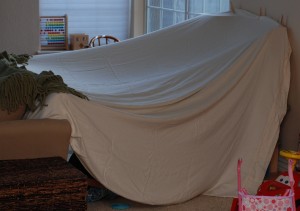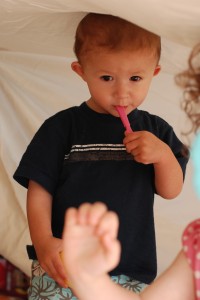
Today I am so happy to have Katie from Playing with Words 365 doing a guest post. Katie is a Mom and a licensed and credentialed Speech-Language Pathologist. She specializes in Preschoolers ages 2-5. Katie blogs so that we have a LOT of ideas to do with our child to help expand their speech and language skills. Her blog is filled with super creative ideas to make the most of playtime. Plus she hosts a weekly linky party – Thrifty Thursdays - with even more great ideas. Check out her post below & then head on over to her blog & let her know you are visiting from Living Life Intentionally!
As a speech language pathologist, I am asked all the time by friends, family members, and of course my students/clients parents what they can do to help expand their children's speech and language skills at home. As I have mentioned numerous times on my blog, language is not learned in a bubble. Language is learned all day, every day in every little activity a child participates in from diaper changes to bath to meal time. One of the tools to helping broaden your child's vocabulary and over all language skills is to provide them with a variety of different activities and interactions. I love to think up of FUN and CREATIVE ways to help children with their speech and language skills both for my own children and for my students/clients. I also try to provide activities that are hands-on learning and not-so-much the paper and pencil type (although there is certainly a time and a place for these too!) One of my most fond memories of my child hood was fort building. I would spend hours planning and building indoor forts with my friends and cousins (and sometimes all by myself!). A few months ago my husband built a fort with my daughter E, age three and as I was watching them build and play I realized what an awesome language building experience fort building can be! We recently made another fort in our living room and both my three year old and my one year old LOVED IT!

(Our little fort)
Want some tips on how to make a great fort? I found this great article on how to build a blanket fort at Simple Mom. Be sure to check it out, he has some AWESOME suggestions and tips! To build a simple fort you will need some basic fort building materials:- Large sheets work well for the roof and walls, as well as blankets or quilts
- Sturdy furniture like couches, chairs, and tables
- Pillows and Cushions
- Clothespins and/or rubber bands (to help secure the sheets and blankets)
- Nouns: At the very least, you can target all the names of the supplies that you will be using to build your fort: Sheets, blankets, quilts, pillows, furniture pieces, clothespins, etc. You can also target part/whole relationships by targeting the parts of the fort: The roof, the walls, the floor, the door, windows, spy hole, tunnel, etc.
- Verbs: Because this is a hands-on activity, you can target all the verbs related to building , making, and taking down.
- Prepositions: Fort building is GREAT for working on prepositions! As you build, talk about and pose questions about the location of your materials and where to place your materials. i.e. on, off, under, over, on top, beneath, in front, behind, etc.
- Problem Solving: Any kind of building takes problem solving skills but fort building especially! As you build, things might not work. Talk about WHY they didn't work and what you need to do to solve the problem. SO much opportunity for language and vocabulary building during problem solving activities!
- Sequencing and Storytelling: Can you put the roof on the fort before the walls are up? Of course not! Building must happen in sequence to be effective. A great way to work on sequencing events is to take pictures step-by-step as you build your fort. Afterwards, print out the pictures or bring them up on the computer and talk about each step...have your child put the pictures in order and tell the "story."
- Following and giving directions: This is a given. You and your child will both have ample opportunities to give each other directions on how to build your fort.
- Asking and Answering questions: Where should we build the front door? Where should we put these pillows? What kind of fort should we build (castle? ship? car?) Why is this not working? Who should come play with us? When should we clean up? The fort building process will prompt LOTS of opportunities for answering and asking questions.
- Social/pragmatic skills: Building a fort is an EXCELLENT activity to work on social/pragmatic language skills. Not only does fort building promote the use following and giving directions as well as asking and answering questions but it also provides opportunities to work on the following (especially during play after the fort is built) eye contact, topic initiation, topic maintenance, personal space, imaginative play skills, sharing, etc.
- Syntax and Semantics: Yes, you can even work on syntax and semantics! Right now my daughter is struggling with some pronouns. She says "Where is him?" rather than "Where is he?" so we worked on this during our play time in the fort. She would ask where he brother was and I would correct her ("You mean where is HE?") and she would repeat it back to me correctly and I would then answer her question.
- Predicting: Fort building is a great activity to work on predicting skills. Will the sheet reach all the way from the couch to the table? What do you think will happen if we roll a ball on the roof...will the roof cave in? What do you think will happen if we take this chair away? Etc. Have FUN with this...as you go along you can pose different questions to have your child predict the answer. Have your child explain WHY he/she predicts something and talk about why or why not the prediction was accurate.

(Ev playing in the fort. My daughter wouldn't allow pictures! HA!)
Do you see how much LANGUAGE is used/learned by making and playing in a simple fort? Not to mention general cognitive skills, visual processing/planning skills, and fine and gross motor as well! To make the most out of this activity, be sure to use the following strategies with your children: Parallel Talk, Self Talk, & Descriptions Expansions, Extensions, and Repetitions Commenting and Asking Questions Looking for more ideas on how to work on your children's speech and language skills at home? Be sure to check out my posts on expanding language skills during craft time, at the park, and while playing with simple toys!
I want to thank Beth for this fantastic opportunity to be a guest poster on her fabulous blog! This had been such a pleasure! :D
Thanks Katie! Who knew building a fort could be so educational =-) YEAH!! Here are some of my favorite posts from Playing with Words 365


0 comments:
Post a Comment